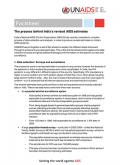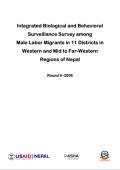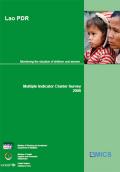What's New
Displaying results 4271 - 4280 of 4914

Resource | Publications,
This report provides biological and behavioural information of HIV related high-risk groups (HRGs) from the 3rd round of surveillance, conducted from March to June 2008 in Pakistan. The study was a cross-sectional behavioral and biological survey of three HRGs including Injecting Drug Users (IDUs), Male Sex Workers (MSWs), and Hijra Sex Workers (HSWs).

Resource | Fact Sheets,
India’s National AIDS Control Organization (NACO) has recently completed a complex process of data collection and analysis, in order to produce revised estimates on India’s AIDS epidemic.
UNAIDS has put together a set of fact sheets to explain the different steps India went through to produce the revised estimates. This is the first fact sheet which explains the data collection process and gives additional background information on the specific surveys and surveillance.

Resource | Publications,
This is the second round of the Integrated Biological and Behavioral Surveillance Survey (IBBS) conducted among 360 migrant workers in five districts of the Western development region and another 360 migrants of the Mid to Far Western development regions. The field survey was carried out during the months of June to September 2008. The survey measured HIV and STI prevalence among migrant workers, as well as condom use, sexual behaviors, knowledge of HIV/AIDS and exposure to HIV/AIDS messages, cases of sexually transmitted infection (STIs), STI treatment behaviors, and drug habits.

Resource | Publications,
The Lao PDR Multiple Indicator Survey is a nationally representative sample survey which was conducted between March and June 2006. In the 5,894 households successfully interviewed nationally in the survey, 33,100 household members were listed. Of these, 16,467 were males and 16,633 were females. The average household size found in the survey was 5.6.

Resource | Publications,
Many times, paperwork and these administrative obligations delay rape survivors' access to some RH services, such as emergency contraception pills (ECP) or post exposure prophylaxis (PEP), because many of these services have small windows of time (72 hours) in which they can be administered effectively. Unless health service staff are aware and able, many of these women may miss their opportunity to obtain certain RH and HIVforms of care.
To evaluate the current environment, a situation analysis of post-rape care services available at the first point of contact was conducted. The aim of this investigation was to gather information that could be used in the development of a comprehensive care and support system for the rape survivor. Secondarily, the study field-tested sensitive and practical tools that could be used in the future for large-scale situation analyses of the rape survivor services. This study was carried out in three cities in India (Delhi, Lucknow, and Vadodara) and four cities in Bangladesh (Dhaka, Chittagong, Sylhet and Tangail).

Resource | Publications,
There is an urgent need to address the emerging and re-emerging epidemics of HIV and other sexually transmitted infections (STIs) among men who have sex with men (MSM) and transgender people. Strengthening strategic information systems and implementing interventions for the prevention and treatment of HIV and other STIs among MSM and transgender people should be considered a priority for all countries and regions as part of a comprehensive effort to ensure universal access to HIV prevention, care and treatment.
A meeting held on 15–17 September 2008 in Geneva brought together participants from the World Health Organization (WHO) and its United Nations (UN) partners along with representatives from 26 countries to discuss the role that the health sector can and should play in addressing prevention, treatment and care of HIV and other STIs among MSM, transgender people and their sexual partners.

Resource | Publications,
Outline:
- The essential criteria for a National Strategic Plan
- The importance of prioritization
- Effective intervention
- The cost dimension
- Other vital elements
- Resources: Training agenda and manual, templates, toolbox, reference readings

Resource | Publications,
The objectives of this assessment include:
1. To describe the characteristics of MSM with particular attention to adolescent and young males within community, entertainment, and congregate settings in Kabul, Kandahar, and Mazari-sharif as it pertains to HIV prevention.
2. To assess the circumstances of child abuse/exploitation within the context of MSM within communities, entertainment, and congregate settings in Kabul, Kandahar, and Mazar.
3. To strengthen the knowledge base for the HIV national response for MSM and child abuse/exploitation among the government, donors, and NGOs.
4. To make recommendations for a stronger capacity among the government, donors, and NGOs for appropriate service delivery on HIV prevention, care and support for MSM and children at risk of child abuse/exploitation.
5. To review the development of MSM community-based self-help and other appropriate approaches to HIV prevention, to reduce stigma and discrimination, and to reduce violence against children.
This desk review of current literature on male-male sexualities, behaviours and sexual exploitation in Afghanistan is a part of the rapid assessment of male vulnerabilities to HIV and sexual exploitation in Afghanistan.

Resource | Fact Sheets,
The aim of this study was to assess the knowledge, attitudes and practices of primary health care providers regarding the identification and management of domestic violence in a hospital based primary health care setting. A survey was conducted of all clinicians and nursing staff of the outpatient, casualty and antenatal clinics in University Malaya Medical Centre using a self-administered questionnaire. Lack of positive attitude and positive practices among the staff towards domestic violence identification and management might be related to inadequate knowledge and inappropriate personal values regarding domestic violence.

Resource | Publications,
This study is the third round of the IBBS and was conducted from June through to August 2008, among 200 female sex workers (FSWs) in Pokhara. The study was undertaken to measure the prevalence of HIV and syphilis, and associated risk behaviors, among FSWs. Demographic and sexual behavior data were collected through a structured questionnaire, while the prevalence of HIV and syphilis were selectively measured by blood samples.





